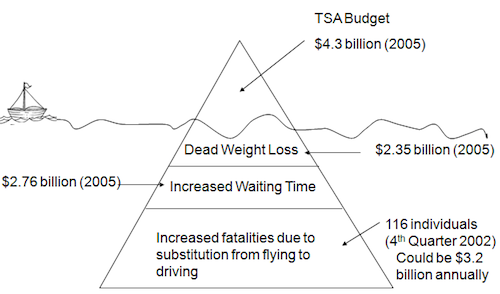- | Regulation Regulation
- | Expert Commentary Expert Commentary
- |
What Are the Indirect Costs of Regulation?
-
Congress is debating whether to make federal agencies estimate “indirect” costs of the regulations they propose. Skeptics suggest the term is too vague.
In reality, a requirement to estimate indirect costs need not create a Pandora’s grab bag of miscellaneous and poorly specified cost calculations. A little bit of economics goes a long way toward defining indirect costs of a regulation in a coherent way.
Indirect costs are the costs to society that occur when people change their behavior in response to incentives created by the regulation. Major indirect costs include value lost when people cut back purchases in response to regulation-induced price increases, reductions in quality or convenience caused by regulation, and risk/risk tradeoffs.
That’s a mouthful of complicated language. But airport security regulations provide a familiar example of all three indirect costs. The accompanying graphic, based on a Mercatus study published several years ago, identifies several major costs of airport security screening. The obvious, direct cost is the money spent to pay for Transportation Security Administration (TSA) screeners. But that’s not the only or even the largest cost.

The people who continue to fly also feel some costs in addition to the ticket fee. They spend more time waiting around to get groped in airports. The increased waiting time alone was worth $2.75 billion in 2005, based on the Department of Transportation’s own estimates of the value of an hour of waiting time.
Finally, airport security regulation also increases some people’s risk of dying in travel accidents. Peer-reviewed economic research found that new post-9/11 airport security regulations increased highway deaths by 116 people in the fourth quarter of 2002. Many people taking short trips substituted automobile for air travel, and auto travel is riskier than air travel.
Focusing on social costs also reveals what factors should not count as indirect costs. Job losses, for instance, are not a cost of regulation. They are just an example of how regulation redistributes opportunities from some members of society to others. Airport security regulation destroyed the jobs of contractors who used to operate checkpoints pre-9/11, but it created jobs for TSA agents and people who manufacture 3-ounce travel-sized bottles of shampoo. The only job-related costs of regulation are the transition costs of moving people from one set of jobs to another.
Like an iceberg largely submerged below the surface, indirect costs are hidden—but dangerous to ignore.